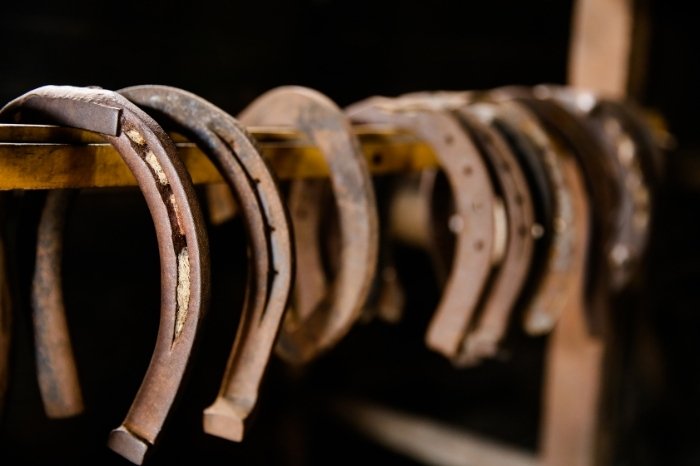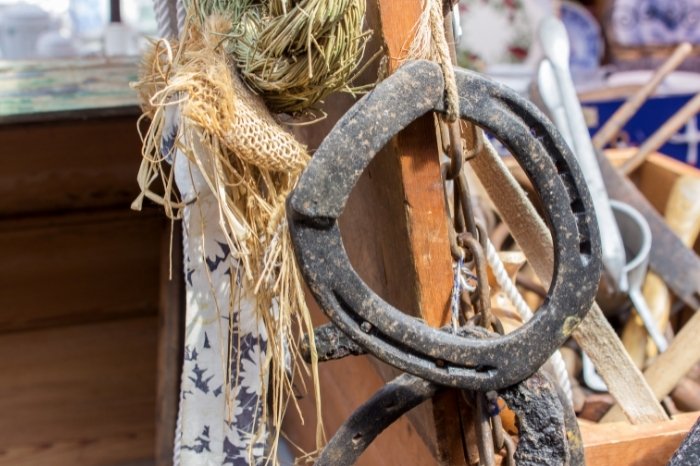Last Updated on February 5, 2022
Everyone knows that horses can wear shoes, but what does this mean? And are there different horseshoe types and uses?
What Are Horseshoes? Different Horseshoe Types And Uses
Horseshoes are a product usually made out of metal that is designed to protect a horse’s hoof from wear and damage. Shoes are usually nailed to the horse’s hoof, but in some cases, they can be glued.
Only a specially trained farrier can shoe a horse. They are trained to determine what kind of shoe would be best, how to best attach it, and how to keep the horse as comfortable as possible while they do it. There is a very slim margin for error while nailing a horseshoe to a hoof, but farriers with much experience work quickly and efficiently.

Why Do Horses Wear Horseshoes?
Horses in the wild have been living for centuries without horseshoes, so are they really essential for horses today? That answer is different for each horse.
Some horses today do great without the support of shoes. This makes things easier for owners and horses!
However, horse hooves are put under much more stress in our modern world than horses who are out in the wild. Hooves are worn down much quicker after being on pavement, concrete, and other surfaces commonly found today. Additionally, the extra wear or being ridden, performing at high levels, and carrying or pulling extra weight adds additional stress on hooves.
Owners can also prolong the life of their horses who have had hoof or leg injuries by giving them the extra support they need through shoes. Horseshoes prevent hooves from splitting, wearing unevenly, and bruising excessively.
Click Here to Learn About:
Different Horseshoe Types And Uses
As mentioned, there are a variety of shoes available for the different needs of the horse. Farriers and owners will make a decision on which shoes to use based on what kind of work the horse is in, how heavy or light the work is, the confirmation of the horse, and if the horses have any problems, diseases, or injuries to their hoof.
Farrier Tools 16-inch Horseshoe File Suit
Here are some common horseshoes you may see and work within your local barn.
Regular Shoe
Most people have come across a regular horseshoe in their lives (game of throwing horseshoes, anyone?) This horseshoe does a great job of protecting the horse’s hoof from normal wear and tear.
Most of the time they are premade by a machine and called a “keg” shoe. Nails can comfortably sit in the shoe and help keep it secure.
Bar Shoe
Bar shoes are fully enclosed in the heel area, but still fit to form to the horse’s hoof. This extra “bar” in the back of the hoof provides support to the horse’s heel. It can also strengthen the whole leg. Horses who have hoof injuries often benefit from a bar shoe.
Why not give all horses this extra support? Hooves are elastic and expand and contract when the horse steps down on them. Putting a bar shoe on the hoof limits the natural movement of the hoof. Also, some horses overreach with their back legs and can easily pull off a shoe that has a back bar to it.
Egg Bar – Different Horseshoe Types And Uses
The egg bar shoe is similar to the normal bar shoe. However, where the bar shoe is straight in the back, the egg bar is curved and extends beyond the heel. This provides even more support to the hoof. This is often helpful to horses who have a navicular disease.
Some horses need the extra support of a wedge to lift the horse’s heel, and the egg bar shoe makes it easy to add a wedge either on the shoe itself or with extra padding.

Heart Bar
Heart bar shoes are fully enclosed just like the other bar shoes. In addition, part of the shoe extends to support the frog. Horses with laminitis often need extra frog support. A farrier may add pads or packing materials to add additional comfort to the hoof.
Horses who have large cracks or damage to their shoes often benefit from a heart bar shoe as well. They do a good job of holding the hoof together and preventing the wall from separating or a crack from widening. They are usually a temporary fix but are becoming more common with farriers today.
Aluminum Shoes – Different Horseshoe Types And Uses
Most shoes are made out of steel, but occasionally you will find one made out of aluminum. Aluminum shoes are much lighter, which makes them more useful in racehorses. They also allow for easier movement in horses who are competing in dressage.
While this seems like it would always be the preferred choice, they are less strong and long-lasting than steel shoes. Horses that compete in jumping, polo, and western disciplines may need a more solid shoe than what an aluminum option can offer.
Winter Shoes
Yes, just like putting winter tires on your car, horses can get seasonal winter shoes too! Rim shoes allow for more traction in wintertime.
Additionally, a farrier may add removable or semi-permanent studs in the shoes to allow for better grip over ice and snow. Horses can also easily develop packed snowballs in their shoes which are almost impossible to remove. This is inconvenient for the owner and may cause injury to the horse if not attended to for too long.
The farrier may choose to add full pads with a center bubble to prevent snow from building up. Tube rim-pads that fit between the shoe and hoof wall provide the best anti-snowball help while also keeping the hoof open.
Horseshoes For Each Horse
There are many different types of horseshoes. And they are not one size fits all!
The kind of shoe that is best for your horse should be carefully discussed with your farrier, trainer, and even your vet. Horseshoes can be a great tool for giving your horse extra support and assistance they need, but they can also cause damage if not fitted properly.
The best thing you can do in deciding what is best for your horse is stay informed, do your research, and trust the professionals!

